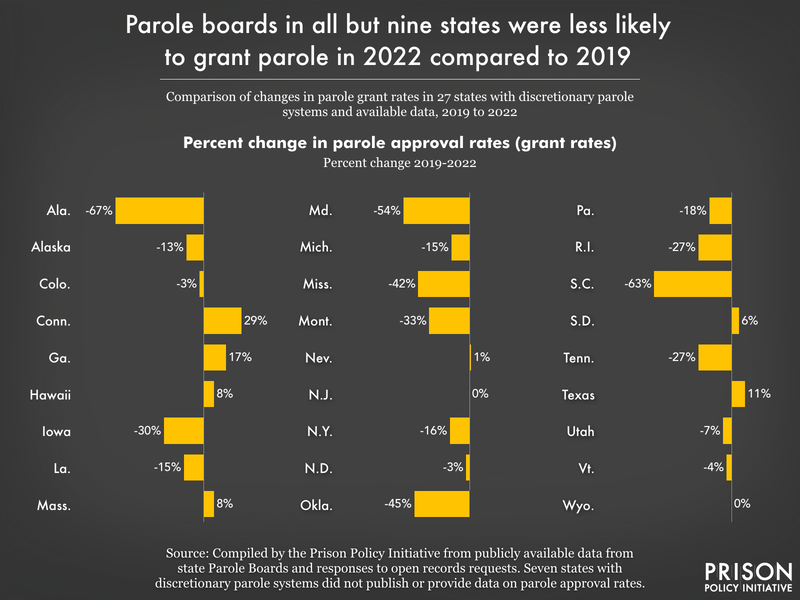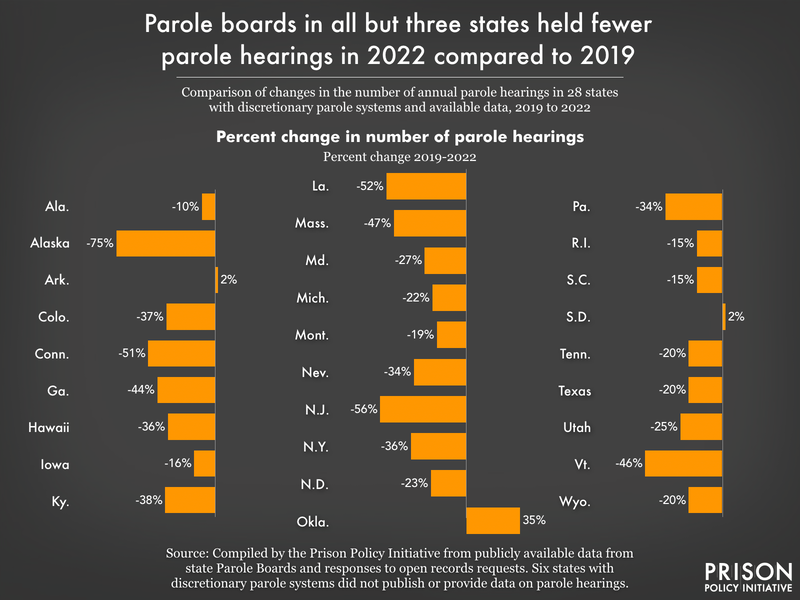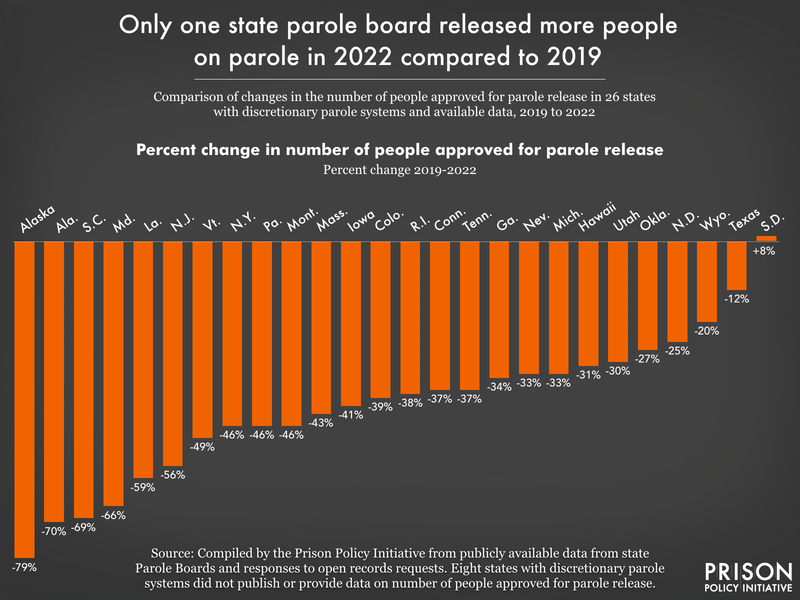No Release: Parole grant rates have plummeted in most states since the pandemic started
Among the 27 states we surveyed, only 7 saw an increase in parole approval rate, and almost every state held substantially fewer hearings than in years past.
by Emmett Sanders, October 16, 2023
Note: On October 18, 2023, we made two edits to this piece : (1) Added data from Massachusetts that was released shortly after our analysis was published, (2) Fixed minor transcription errors to the appendix table.
Earlier this year, Alabama’s Board of Pardons and Paroles made headlines when it denied parole to someone who had died ten days prior to their parole hearing. This is just one of many threads in the Alabama parole board’s tapestry of dysfunction. For months, their three-person parole board operated with just two members despite requiring a majority vote to grant parole. It is no wonder that Alabama is on track to have a parole grant rate — the percent of parole petitions approved — of just 7% for 2023. This also comes as studies show racial disparities in parole grant rates are widening: for example, non-white people in New York were released at a rate almost 29% less than their white counterparts in 2022 (up from a difference of around 19% between 2016 and 2021).
With parole board practices so much in the news, we thought it was important to look around the country and evaluate the direction in which state parole boards are moving. We filed dozens of records requests and curated the best research to explore whether state parole boards are helping reduce mass incarceration or whether they are disregarding the hard-learned lessons of the pandemic, when they released even fewer people than before the crisis as people died behind prison walls.
The state of parole
In the 29 states1 for which we collected 2022 parole approval data, only 8 had grant rates above 50% – Connecticut, Idaho, Massachusetts, Nevada, North Dakota, Utah, Vermont, and Wyoming. Wyoming had the highest grant rate of 78%. At the other end of justice’s sliding scale, Alabama (10%) and South Carolina (13%) have the lowest parole approval grant rates in the nation. And while we don’t yet have data from most states for 2023, South Carolina’s recently updated parole data show that the state’s parole approval rate has dropped to an astonishingly low 7% in 2023.

With few exceptions, parole grant rates dropped significantly from 2019 to 2022
In the 27 states for which Prison Policy Initiative was able to track changes in parole approval rates from 2019-2022, only 6 — Connecticut (+29%), Georgia (+17%), Texas (+11%), Hawai’i (+8%), Massachusetts (+8%), South Dakota (+6%), and Nevada (+1%) — have seen any increase since 2019. In the remaining 20 states from which we received data, parole grant rates have seen either no change or have seen a marked decline, with South Carolina (-63%) and Alabama (-67%) seeing the biggest drop offs in grant rates.
But state parole boards did not only choose to release fewer people. They heard fewer cases as well. With the exceptions of Oklahoma, South Dakota, and Arkansas, parole boards continued to hear significantly fewer total cases in 2022 than they did in 2019. The result is that since 2019, the number of people released through discretionary parole has decreased across the board.

Ironically, South Carolina’s Department of Probation, Parole, and Pardon Services’ website is quick to highlight the money the state has saved by reducing the number of parole revocations over the past decade. Of course, it would be difficult to have more revocations, given that they released 69% fewer people via discretionary parole in 2022 than they did in 2019. South Carolina is far from alone, however. Alaska has reduced the number of people released through discretionary parole by 79% since 2019; Alabama 70% and Maryland by 66%. In fact, with the exception of South Dakota, every state for which data was provided released fewer people through discretionary parole in 2022 than in 2019, with an average overall decline of around 41% fewer people released per state. South Dakota’s increase is also extremely modest – the state released just 62 more people in 2022 than in 2019.

Why are parole boards releasing so few people?
Denial is often effectively the default disposition for parole boards, and the burden of proof is usually on the person who is incarcerated to justify their release. This is problematic, as the board often considers factors that are beyond the applicant’s control, such as the availability of programming or education in the prison, or factors that cannot be changed, such as the nature of the offense for which they were incarcerated. When release rests on these factors, there is very little a person can do to influence the outcome.
Another issue is the general outlook some politicians and parole board members have toward people who are up for parole. State Representative Matt Simpson defended Alabama’s abysmal grant rates, saying “We’ve gotten to a point where the people up for parole are the ones that don’t need to be out; it’s not like it used to be where we had a number of non-violent offenders.” While recent reports have cast doubt on this claim, it still begs the question: how can those with this viewpoint provide a fair hearing to those who come before them? There is nothing fair about a body that decides people’s fates before they ever appear. It’s important to note that the seriousness of an offense is taken into account when a judge first sets a prison sentence. When parole boards solely or exclusively make their release decisions based on the underlying charge, they are continually punishing incarcerated people for a factor they cannot change. Moreover, policies that provide relief only for those with non-violent offenses are simply not impactful enough to address the juggernaut of mass incarceration. And although parole boards are charged with looking at a person’s likelihood of rearrest, they often seem to ignore the fact that people sent to prison for violent charges have the lowest rearrest rate of any group.
Parole Boards are influenced by politics
In 2019, Mississippi had a grant rate of 74% — one of the highest rates in the nation. However, that same year, the parole board made the ethical but unpopular decision to parole a person who had been incarcerated for 30 years. That person had their death sentence commuted on the basis of intellectual disability but the board determined them not to be a threat to public safety. In the aftermath of this decision, Mississippi saw its grant rates freefall 42 percent by 2022. The political outrage at the decision led to increased scrutiny and political pressure which has undermined Mississippi’s presumptive parole system.2
Though parole boards are typically thought of as serving a judicial function (i.e., weighing evidence and rendering a judgment that results in freedom or continued incarceration), they are still bureaucratic bodies beholden to political good will. Parole board members are usually appointed by governors and confirmed by legislative hearings, which often makes their selection fundamentally political. More than a third of states with parole boards in the US mandate no qualifications to sit on the board, meaning no actual knowledge of law, prison, the judicial system, mental health, or even basic social dynamics are required to sit on boards that can prevent a person from ever again experiencing life outside prison walls.
Policy efforts to increase release rates are often stalled or undermined
Efforts to restore discretionary parole in Maine, Virginia, and Illinois led by groups like Parole4ME and Parole Illinois have come achingly close to success in recent years. Some states with discretionary parole have begun to implement presumptive parole in an effort to increase fairness and remove subjectivity and political pressure. While presumptive parole is a key strategy to reduce incarceration, in states that have implemented it, the efficacy of this policy is limited by carveouts — exceptions in policies that exclude certain categories of people from relief. Most states with some form of presumptive parole will not apply the presumption to people with certain offenses, those who have received recent disciplinary infractions, or those who haven’t completed relevant rehabilitative programming. As we noted, offense-based carveouts do not have a strong basis in policy, and programming-related carveouts are problematic because programming is neither universal nor guaranteed and can vary immensely from prison to prison.3 Reports have also shown that Black and Brown people who are incarcerated are more likely to receive disciplinary infractions than their white counterparts, meaning they are more likely to be denied presumptive parole based on this carveout.
Conclusion
Despite the dangers of incarceration in a post-pandemic world and the efforts of many to make the parole system more just, fewer people are receiving parole hearings, and fewer still are released through discretionary parole. In fact, discretionary parole accounted for only a small fraction of total releases from prison in 2021.
Expanding access to discretionary parole won’t by itself end mass incarceration; however, expanding its usage in conjunction with presumptive parole while eliminating undermining carveouts could be a powerful tool for decarceration. Hopefully, a review of parole in 2023 will see incarcerated people given a greater chance to be paroled.
Footnotes
-
While we sought to collect data from all 34 states with discretionary parole as a primary mechanism of release, not all states make parole board data publicly available and several were not forthcoming with data via records requests. Arkansas has a residency requirement for records requests that prevented submission; Missouri denied having records responsive to our request, which strains credulity; New Hampshire cited the records as exempt. We are awaiting data for Nebraska, and West Virginia. Kentucky and Idaho provided some information, but were unable to provide statistics for 2019. In the appendix to this briefing, we provide details about each state’s response to our open records requests. ↩
-
Presumptive parole is a form of non-discretionary parole in which people are automatically released if they meet certain established criteria. ↩
-
New Jersey’s programming requirement for Administrative Parole Release eligibility (that state’s equivalent of presumptive parole), for instance, includes a provision that people will not be disqualified from APR if programming was unavailable. ↩
Appendix tables
Discretionary Parole Grant Rates by state, 2019-2022



